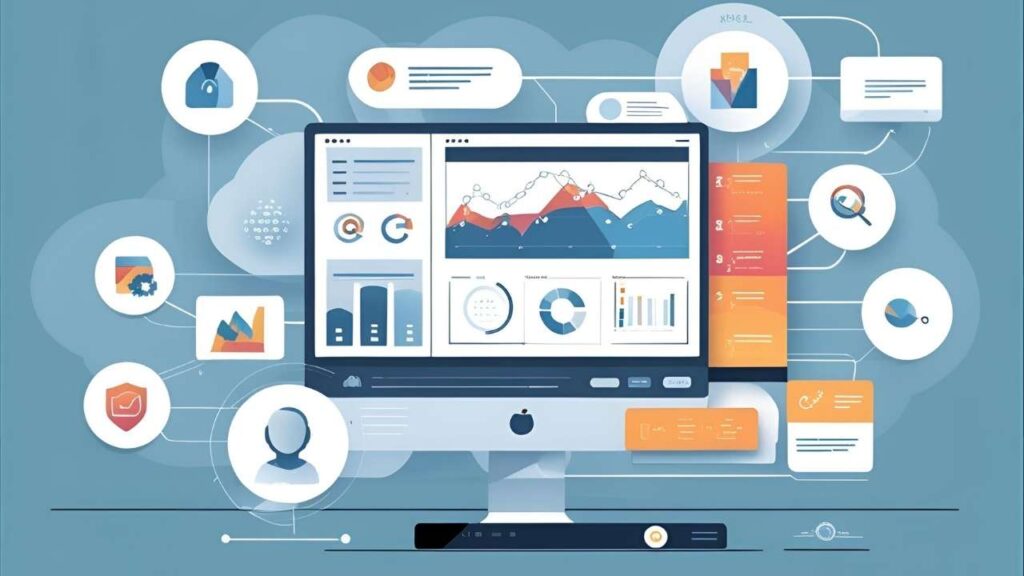By 2025, making decisions data-based is one of the key aspects to consider in successful marketing campaigns. As customers interact with brands in several touchpoints and channels, businesses require advanced tools to monitor, examine, and enhance their marketing results. The contemporary environment of marketing requires an accurate measurement of the essential metrics, such as return on investment (ROI), engagement rates, conversion paths, and attribution modeling to realize which channels and campaigns deliver actual business output.
The marketing analytics platforms used to be straightforward reporting systems, but now they have become complex intelligence systems with intelligent insights in every possible channel that can drive action. These sites allow marketers to stop thinking in terms of vanity metrics and instead consider revenue-driving actions and customer lifetime value. They come with the capacity to trace customers along the entire journey until the last conversion to give the visibility required to streamline marketing expenses and deliver superior advertising.
Modern marketing campaigns are too complicated and demand instruments that could be applied to multi-channel attribution, real-time data processing, and predictive analytics. In the context of this detailed review, we considered marketing analytics platforms in terms of feature comprehensiveness, integration capacity, user-friendliness, pricing model, scalability, quality of customer support, and provision of actionable insight that leads to business growth.
Why Marketing Analytics Platforms Are Essential in 2025
The 2025 marketing environment is both more complex than ever and more full of opportunity than ever before. Following are the potential reasons that make marketing analytics platforms essential:
1. Complexity of Multi-Channel Campaigns
Ads, social media, email, content, voice search, AR, and influencer marketing will require manual tracking, which is not feasible. Analytics platforms play a great role in handling and analysing bulky data.
2. Demand for Personalization
Consumers expect tailored content and timely responses. Behavioral and preference-based tracking using analytics tools is also used to drive lots of recommendation-based tools, dynamic content, and targeted advertising.
3. AI-Powered Predictive Insights
AI and ML turn data into predictions based on churn, lifetime value, and campaign impressions, enabling marketers to operate proactively in real time.
4. Budget Justification and ROI
Tight budgets demand proof of impact. Attribution models and revenue tracking found on analytics platforms help to associate work with outcomes as a preference in making more objectively intelligent investment decisions.
5. Real-Time Optimization
New technologies provide real-time dashboards and an artificial intelligence flags feature that assist marketers in correcting their strategies to improve their performance and minimize waste.
Top 10 Marketing Analytics Platforms
1. Google Analytics 4
Website: https://marketingplatform.google.com/about/analytics/
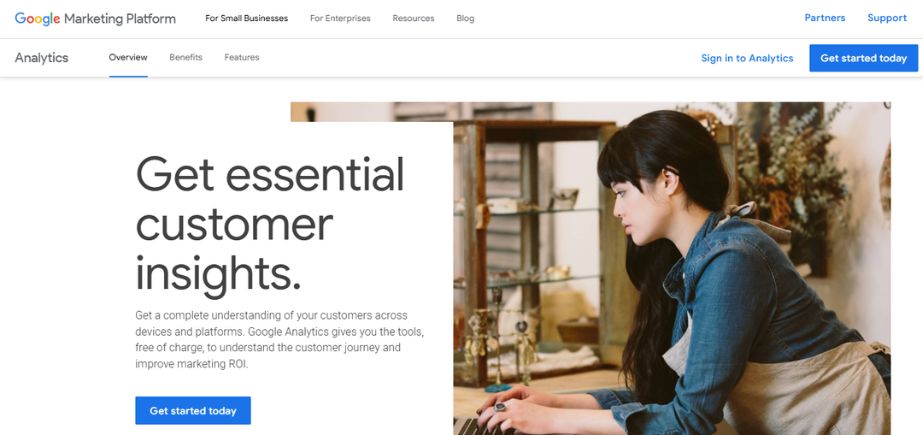
Google Analytics 4 (GA4) is a free and powerful web and app analysis tool with event-based tracking and cross-platform usage. It assists marketers to gauge user behavior along the customer journey, make conversion tracking, and consider the real-time customer journey. GA4 allows in-depth segmentation, predictive measurements, and Google Ads and BigQuery connections. It is suitable in terms of the size of a business since it offers a customizable dashboard and privacy-centered data gathering. GA4 helps to see long-term trends and improves the accuracy of the appraisals of marketing.
Key Features:
- Enhanced ecommerce tracking with detailed product and transaction analysis
- AI-powered insights and anomaly detection for automated reporting
- Cross-device and cross-platform user journey tracking
- Advanced audience segmentation and cohort analysis
- Integration with Google Ads and Google Marketing Platform
Pros:
- Completely free with no usage limits for most businesses
- Seamless integration with Google’s advertising and marketing ecosystem
Cons:
- Steep learning curve compared to Universal Analytics
- Limited customization options for advanced reporting needs
Pricing:
Free for all users with premium features available through Google Analytics 360.
Best Use Case:
Small to medium businesses seeking comprehensive web analytics with strong integration to Google’s advertising platforms.
2. HubSpot Marketing Analytics
Website: https://www.hubspot.com/products/marketing/analytics
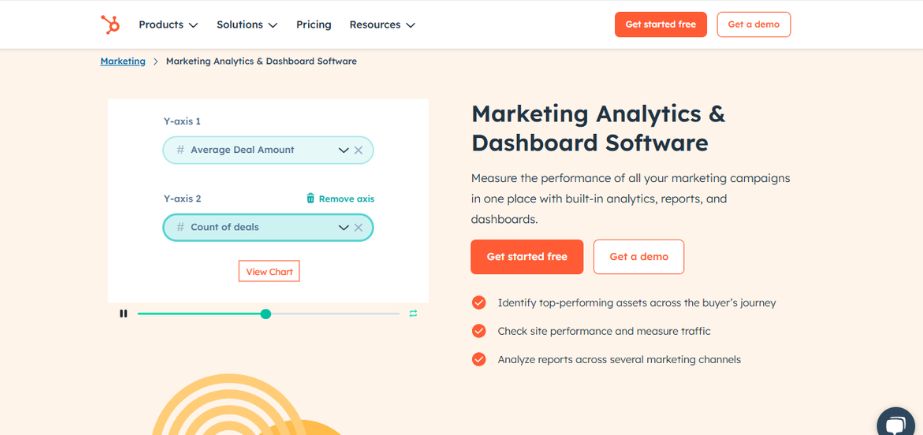
HubSpot Marketing Analytics is connected with HubSpot CRM, and the user has complete visibility of the performance of the campaign, measurement of leads, and customer lifelines. It has pre-made traffic, engagement, and ROI dashboards, as well as lifecycle stage dashboards. It gives users the chance to measure everything, such as email opens and conversion of ads. It is the most appropriate for SMBs and inbound marketers but allows customization of reports, A/B testing, and attribution modeling. It is easy to use since it is designed intuitively by non-technical users of marketing campaigns that are integrated.
Key Features:
- Integrated CRM for complete lead lifecycle tracking
- Multi-channel attribution modeling across all marketing touchpoints
- Revenue attribution and ROI tracking for all campaigns
- Custom dashboard creation with drag-and-drop functionality
- Automated reporting and performance alerts
Pros:
- Seamless integration between marketing and sales data
- User-friendly interface with comprehensive training resources
Cons:
- Higher costs for advanced features and larger contact databases
- Limited flexibility for complex custom reporting requirements
Pricing:
Free tier available, paid plans start at $45/month for marketing features.
Best Use Case:
Growing businesses that need integrated marketing and sales analytics with strong lead tracking capabilities.
3. Adobe Analytics
Website: https://business.adobe.com/uk/products/adobe-analytics.html
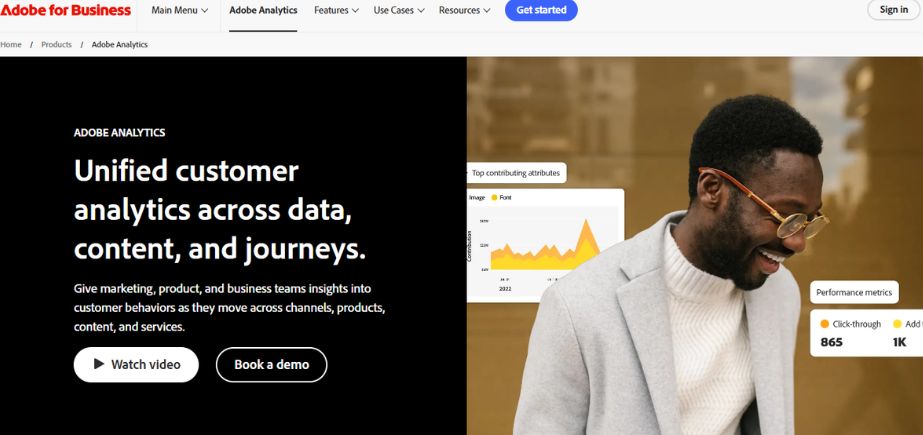
Adobe Analytics is an enterprise-based product that provides advanced real-time analytics, predictive analytics, and detailed customer segmentation. It enables companies to monitor multi-channel behavior and develop an end-to-end customer profile. It uses insightful AI through the Adobe Sensei and analyses trends and predicts performance. Adobe Analytics is suitable for large organizations that require custom reporting and scalability, and Adobe Experience Cloud integrations. It is a sophisticated yet incomparably deep analysis of data that can be used to make highly personalized and data-driven decisions at each touchpoint.
Key Features:
- Advanced segmentation and cohort analysis capabilities
- Real-time data processing and visualization
- AI-powered insights through Adobe Sensei
- Cross-channel attribution modeling and customer journey analysis
- Advanced data governance and privacy controls
Pros:
- Extremely powerful segmentation and analysis capabilities
- Strong integration with Adobe’s marketing technology stack
Cons:
- Significant learning curve requiring specialized training
- High cost structure suitable only for large enterprises
Pricing:
Custom enterprise pricing starting around $48,000 annually.
Best Use Case:
Large enterprises requiring advanced analytics capabilities and sophisticated data analysis.
4. Mixpanel
Website: https://mixpanel.com/
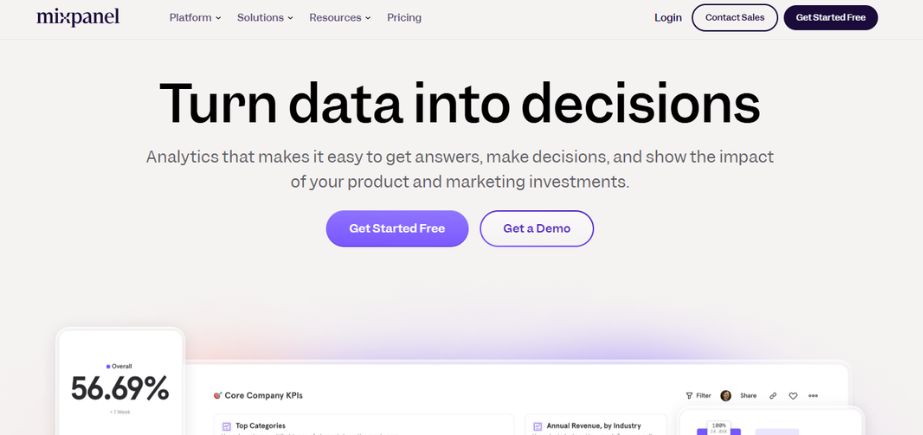
Mixpanel is one of the marketing analytics platforms and product that specializes in user interaction and behavior tracking, both on-web and mobile applications. It is excellent in the area of event-based tracking, cohort analysis, and funnel reports. Mixpanel is the perfect tool to analyze SaaS and tech companies, maximize user engagement, retention, and conversion-related processes. The use of KPIs and the possibility of checking product features can also be tracked in terms of its intuitive interface, whilst real-time data makes it easy to understand. The platform provides insight into A/B testing and aligns well with Segment and Snowflake.
Key Features:
- Event-based tracking for detailed user interaction analysis
- Funnel analysis and conversion optimization tools
- Cohort analysis for user retention and engagement tracking
- A/B testing integration for experimentation
- Real-time data streaming and analysis
Pros:
- Excellent for tracking user behavior and product engagement
- Strong focus on actionable insights for product optimization
Cons:
- Primarily focused on digital products rather than traditional marketing
- Can become expensive with large user volumes
Pricing:
Free tier available, paid plans start at $25/month for additional features.
Best Use Case:
Software companies and digital product teams seeking detailed user behavior analytics.
5. Kissmetrics
Website: https://www.kissmetrics.io/
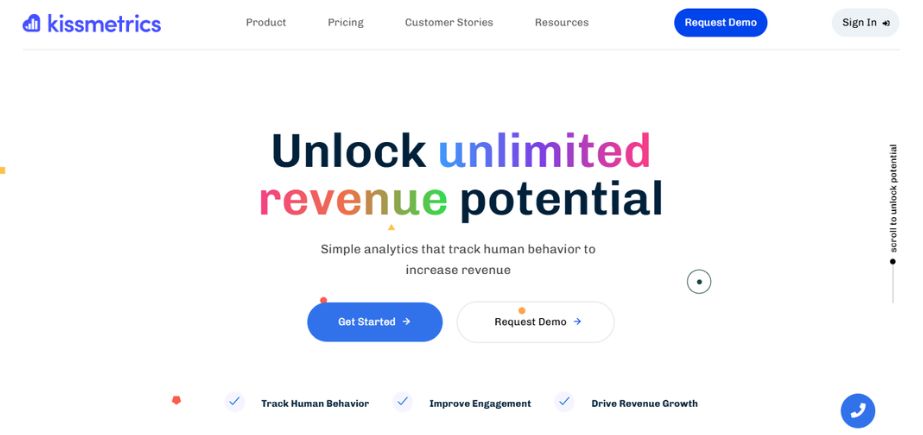
Kissmetrics focuses on customer tracking, behavioural data tracking, and revenue attribution. It was specifically designed to provide e-commerce and SaaS businesses with customer data that can be used to convert high-value customers, optimize funnels, and maximize customer lifetime value. Using person-based tracking, you can extend beyond pageviews and provide insights on how your users engage with your site, specifically by providing actionable insights on how users navigate your site. Kissmetrics provides in-depth retention, churn, and cohort reports. Its support for emails and CRM will facilitate the provision of specific marketing plans and further assessment of campaign performance.
Key Features:
- Person-based tracking for individual customer journey analysis
- Revenue attribution across all marketing channels
- Customer lifetime value calculation and prediction
- Behavioral segmentation and targeting capabilities
- Automated campaign optimization recommendations
Pros:
- Strong focus on revenue attribution and ROI measurement
- Excellent customer journey visualization and analysis
Cons:
- Higher pricing compared to basic analytics platforms
- Steeper implementation curve for complex tracking setups
Pricing:
Plans start at $299/month for basic features.
Best Use Case:
Businesses focused on understanding customer lifetime value and optimizing revenue per customer.
6. Sprout Social
Website: https://sproutsocial.com/
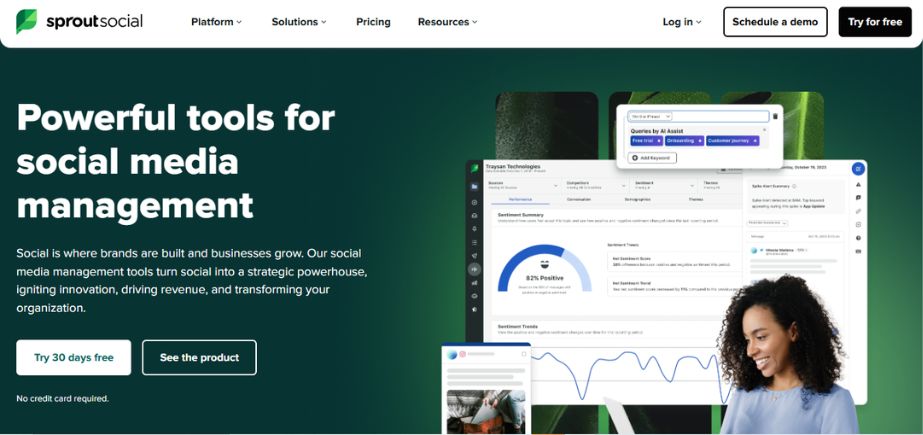
Sprout Social is a social media management tool that integrates strong analytics of such platforms as Instagram, X, LinkedIn, and Facebook. It provides a performance report, audience data, and tracking engagement. Marketers will be able to determine the reach of the content, the optimal posting time, and follow the results of competitors. It also supports team collaboration and customizable dashboards. Sprout is the right tool to ease the data analysis and presentation through a visualized display to social media managers and agencies. It has a user-friendly interface that allows you to arrange content accordingly and do analytics in one place.
Key Features:
- Comprehensive social media performance tracking across all platforms
- Social listening and brand mention monitoring
- Competitive analysis and benchmarking tools
- Team collaboration and workflow management
- Custom reporting and white-label options
Pros:
- Excellent social media-specific analytics and insights
- Strong integration with social media management features
Cons:
- Limited to social media channels only
- Higher pricing for comprehensive analytics features
Pricing:
Plans start at $249/month for analytics features.
Best Use Case:
Businesses with significant social media presence requiring detailed social analytics and competitive intelligence.
7. Funnel.io
Website: https://funnel.io/
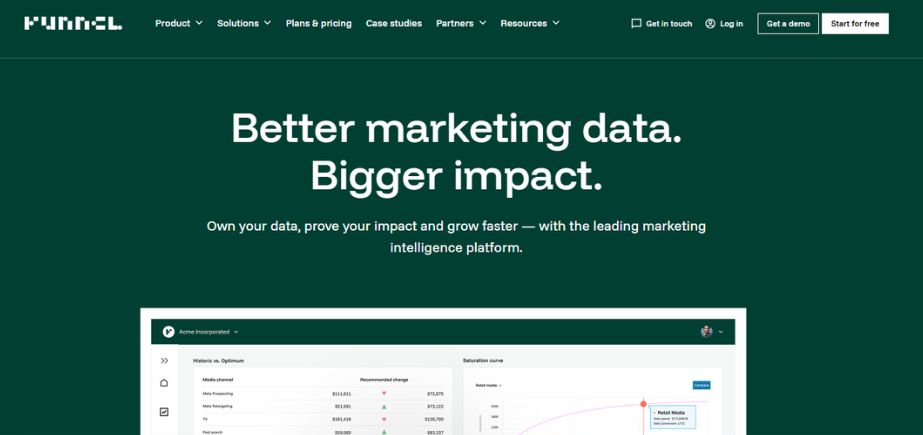
Funnel.io pulls together data from more than 500 marketing sources and centralizes it to a single unified dashboard or transfers it to applications such as Google Data Studio or Excel. It saves time on manually writing reports and manipulating them by automating the process through formatting and gathering of information. Funnel is a perfect fit for performance marketers and agencies that run numerous campaigns and platforms. It allows the use of custom metrics, multiple accounts management, and connection to CRM and ad networks. Its power is in the fact that it simplifies data consolidation, which makes it easier to understand the performance of the campaign on a scale.
Key Features:
- Automated data collection from 500+ marketing platforms
- Data transformation and standardization capabilities
- Custom dashboard creation and visualization
- Automated reporting and data export functionality
- API access for advanced integrations
Pros:
- Eliminates manual data collection and compilation work
- Comprehensive platform coverage for all marketing channels
Cons:
- Focused on data aggregation rather than advanced analysis
- Requires separate visualization tools for complex reporting
Pricing:
Plans start at $499/month based on data volume.
Best Use Case:
Marketing teams managing campaigns across multiple platforms requiring centralized data collection and reporting.
8. Datorama (by Salesforce)
Website: https://www.salesforce.com/in/marketing/analytics/
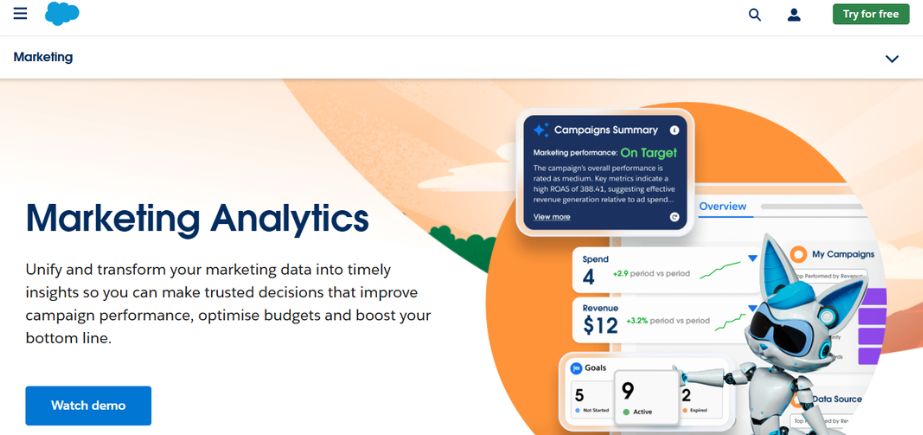
Datorama is a marketing intelligence platform that provides live data connections, AI-based insights, and designable dashboards. It is a component of Salesforce Marketing Cloud, which allows centralizing the marketing data collected by multiple sources to obtain a unified picture of performance. It is best suited to enterprise teams and provides advanced reporting, campaign optimization, and ROI tracking. Datorama also eases multifaceted analytics operations with the help of automation and AI, enabling marketers to make faster decisions based on data. It is easy to analyze in a cross-channel due to its strong visualization capabilities.
Key Features:
- Real-time marketing intelligence and performance monitoring
- Advanced data modeling and transformation capabilities
- AI-powered insights and anomaly detection
- Custom dashboard creation with interactive visualizations
- Strong integration with Salesforce ecosystem
Pros:
- Enterprise-grade platform with robust data processing capabilities
- Excellent integration with Salesforce marketing and sales tools
Cons:
- Complex implementation requiring technical expertise
- High cost structure suitable only for large organizations
Pricing:
Custom enterprise pricing starting around $3,000/month.
Best Use Case:
Large enterprises using Salesforce ecosystem requiring advanced marketing intelligence and real-time analytics.
9. Supermetrics
Website: https://supermetrics.com/

Supermetrics imports marketing data across more than 100 platforms into BI or data warehouses, spreadsheets, or data warehouses such as Google Sheets, Looker Studio, Excel, and BigQuery. Marketers love it as it automates the process of creating reports and gets rid of manual data entry. They allow users to monitor KPIs, create dashboards, and compare the performance of different platforms easily. Supermetrics is ideal in the case where one has a team that requires highly customized reporting, and that team operates on spreadsheet systems. The features are potent, and it beats scale, besides the fact that it accommodates agencies and performance-oriented marketers.
Key Features:
- Automated data pulling from 100+ marketing platforms
- Direct integration with Google Sheets, Data Studio, and BI tools
- Scheduled data refreshes and automated reporting
- Data blending and transformation capabilities
- Custom connector development for unique data sources
- Excellent for creating custom dashboards in familiar tools
- Affordable pricing for comprehensive data connectivity
Cons:
- Limited built-in analysis capabilities
- Requires knowledge of visualization tools for effective use
Pricing:
Plans start at $19/month for basic connectors.
Best Use Case:
Marketing teams comfortable with spreadsheets and visualization tools seeking automated data collection and custom reporting.
10. Looker (Google Cloud)
Website: https://cloud.google.com/looker?hl=en
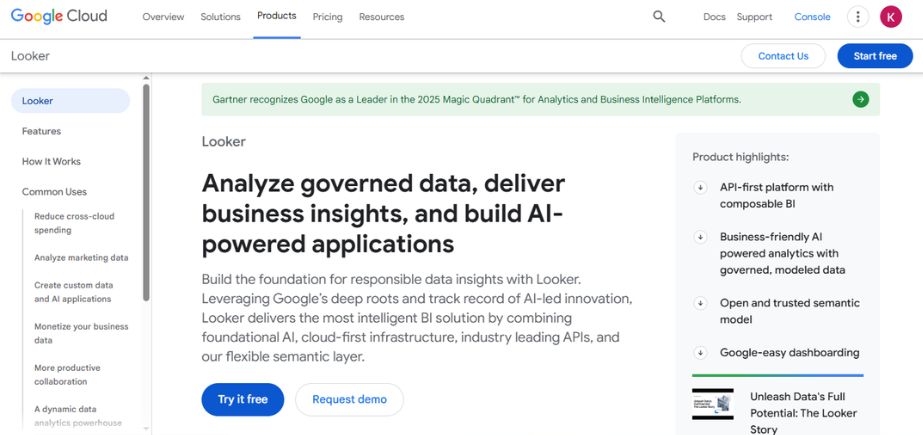
Looker is a data visualization platform and business intelligence tool focusing on enabling users to make sense of complex data and analyze it to come up with a conclusive, actionable understanding. It allows marketers to create their reports and dashboards and analyze real-time performance data across all channels. It offers high data modeling and governance in deep integration with Google Cloud and BigQuery. Looker is an ideal platform for data teams and enterprise marketers to enable companies to deliver marketing strategies that complement the broader business objectives and uses powerful visual tools and a more flexible querying ability.
Key Features:
- Advanced data modeling with LookML language
- Custom visualization and dashboard creation
- Embedded analytics and white-label reporting
- Advanced data governance and access controls
- Strong integration with Google Cloud Platform
Pros:
- Extremely flexible data modeling and analysis capabilities
- Excellent for custom reporting and advanced analytics needs
Cons:
- Requires significant technical expertise for implementation
- Higher cost structure with complex pricing model
Pricing:
Custom pricing starting around $5,000/month.
Best Use Case:
Large organizations with technical teams requiring advanced data modeling and custom analytics solutions.
Comparison Table Between Marketing Analytics Platforms
| Platform | Starting Price | Best For | Key Strength | Primary Focus |
| Google Analytics 4 | Free | Small-Medium Business | Cost-effective web analytics | Website/App tracking |
| HubSpot | $45/month | Growing businesses | CRM integration | Lead lifecycle |
| Adobe Analytics | $48,000/year | Large enterprises | Advanced segmentation | Enterprise analytics |
| Mixpanel | $25/month | Software companies | User behavior tracking | Product analytics |
| Kissmetrics | $299/month | Revenue-focused teams | Customer journey analysis | Revenue attribution |
| Sprout Social | $249/month | Social-focused brands | Social media analytics | Social performance |
| Funnel.io | $499/month | Multi-channel marketers | Data aggregation | Cross-channel reporting |
| Datorama | $3,000/month | Large enterprises | Real-time intelligence | Marketing intelligence |
| Supermetrics | $19/month | DIY marketers | Data connectivity | Custom dashboards |
| Looker | $5,000/month | Technical teams | Advanced modeling | Business intelligence |
Use Case-Based Recommendations
Best for Small Businesses:
HubSpot and Google Analytics 4 are the most useful marketing analytics platforms for small businesses. GA4 provides complete web analytics on a free basis, whereas HubSpot has a free plan with limited marketing analytics and CRM incorporation. Both platforms provide room for growth as businesses expand.
Best for Agencies:
However, Supermetrics and Funnel.io are effective when the agency needs to track numerous clients on multiple platforms. Supermetrics is superbly priced in providing data connection to bespoke client dashboards and Funnel.io, which is effortlessly priced towards offering really in-depth data collection to agencies that are working on complicated cross-channel campaigns.
Best for Enterprise Teams:
Adobe Analytics and Datorama lead in enterprise capabilities. Adobe Analytics has extensive segmentation and analysis capabilities to suit big companies, and Datorama has real-time marketing intelligence with data processing capabilities on an enterprise scale.
Best for eCommerce Brands:
Google Analytics 4 and Kissmetrics provide excellent e-commerce tracking. GA4 provides improved eCommerce functionality, including the possibility to track products and transactions, and Kissmetrics works with customer lifetime value and revenue attribution, which is important to companies with online stores.
Best for Data-Driven Marketers:
Looker and Mixpanel serve the needs of organizations with developed analytics. Looker supports advanced data modeling and customized analysis, whereas Mixpanel offers a keen insight into the behavior of its users to the optimization-oriented marketers.
Conclusion
Marketing analytics platforms in 2025 will provide more advanced solutions to businesses, large and small, and each of these solutions satisfies a particular need and use case in analytics. Varying in complexities, customizabilities, and arrangements of costs, they have ranged from free web analytics platforms to high-end enterprise-grade business intelligence solutions.
Understanding how to align relevant capabilities (an ability to execute different actions on a platform) with business needs, technical skills, and cost constraints is the most significant consideration that a competent marketing analytics professional would apply during the implementation. Comprehensive solutions can be of great use to small businesses using free or low-cost solutions such as Google Analytics 4 and HubSpot, whereas more complex use cases will require additional features that are provided by Adobe Analytics or Datorama.
The cost incurred on shopping for the right analytics tools for marketing campaigns is rewarded with better campaign performance, better resource utilization, and the development of a clear picture of marketing ROI. With the marketing sphere undergoing changes, those platforms will be instrumental in ensuring the maintenance of a competitive edge and business development.
Selections will include a platform that fits into your current needs and comes with the opportunity to grow. Use free trials and demos to get first-hand experience of the platforms to make sure that the system you choose to work with will easily integrate into the current set-up and that you will acquire the type of insights one requires to excel in data-driven marketing.
FAQs
1. What are marketing analytics platforms?
Marketing analytics platforms are software product that aggregate, analyze, and processes marketing data to make viable insights into campaign efficacy, client activity, and ROI. These platforms monitor progress through several channels and give dashboards, reports, and suggestions to maximize the marketing strategies.
2. Is it possible that small businesses can use such tools?
Absolutely. There are a lot of free or inexpensive plans that are tailored to suit small business uses. Google Analytics 4 is entirely free and offers full analytics services, whereas HubSpot has free features with unlimited scalability depending on the needs.
3. Do the marketing analytics have a free alternative?
Yes, there exist some free options on several platforms where you could do this. Google Analytics 4 is free of charge to the majority of businesses, HubSpot provides free basic marketing analytics, and Mixpanel also has a free tier with a small volume of data. These open options offer good value on how to begin with marketing analytics.
4. What is the CRM or ad platform integration of these tools?
The majority of the up-to-date marketing analytics platforms are highly integrated. They also integrate with well-known CRM software such as Salesforce and HubSpot, advertisement systems such as Google Ads and Facebook Ads, and email marketing. Through these integrations, cross-channel tracking and attribution are comprehensive.
5. What are the marketing analytics platforms metrics to monitor?
Pay more attention to the metrics aimed at business: conversion rates, customer acquisition cost, lifetime value, channel ROI, lead quality scores, and attribution data. Only count vanity measures such as likes or impressions when they can directly measure business goals. Your metrics would depend on the industry and the model of your business.
